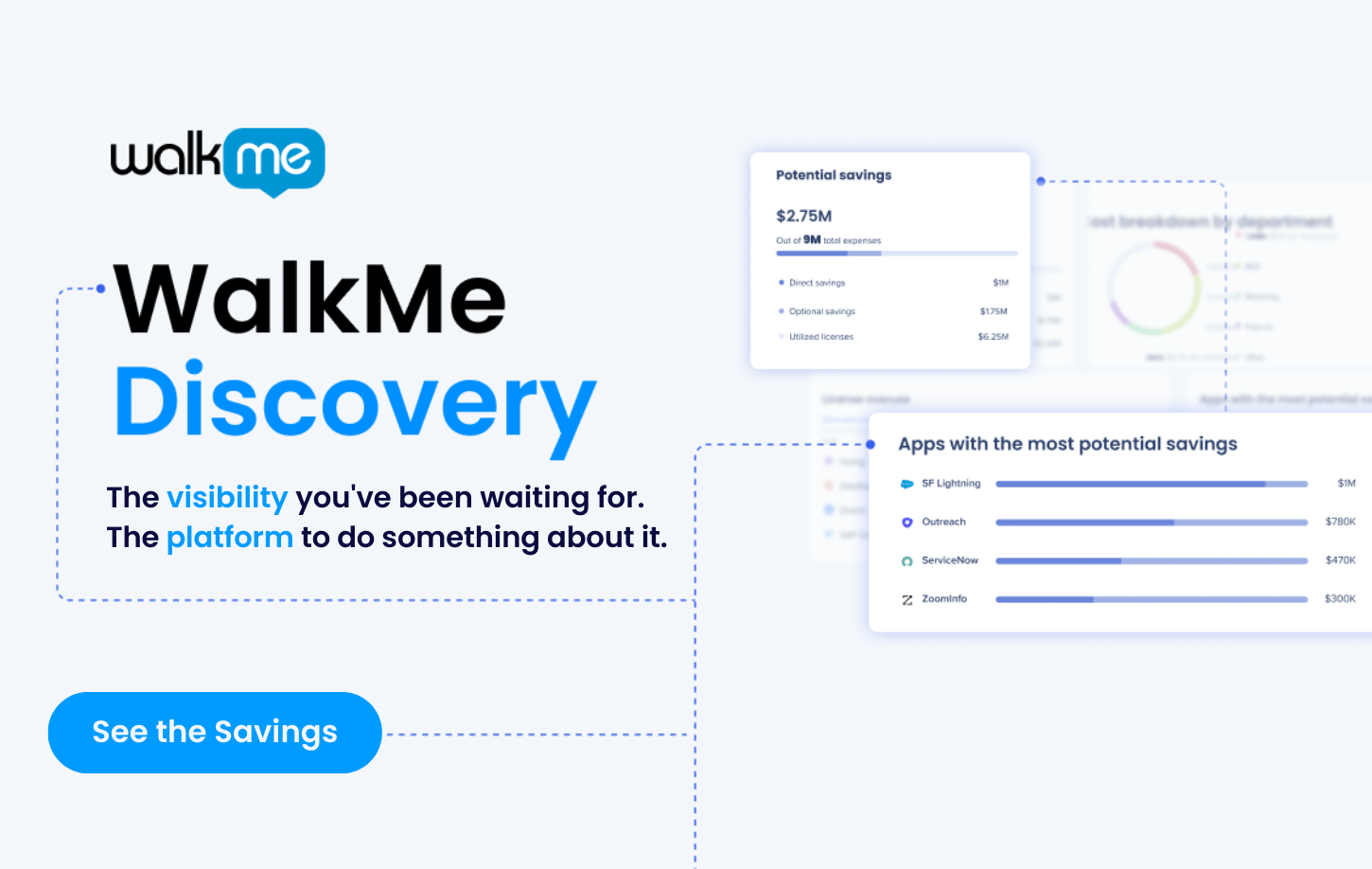You spend millions on new tech, but you’re not seeing the ROI because you’re unsure how to measure the success of these new technologies and their quantified value. What do you do?
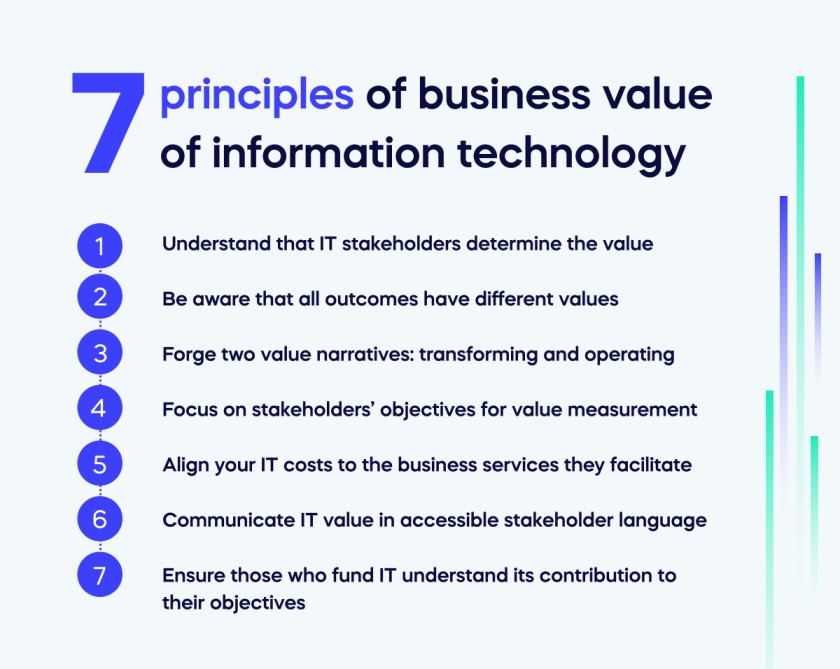
The seven principles of the business value of information technology exist as a solution to this problem. By measuring business value, you can ensure you maximize the ROI on new purchases to maintain growth and success.
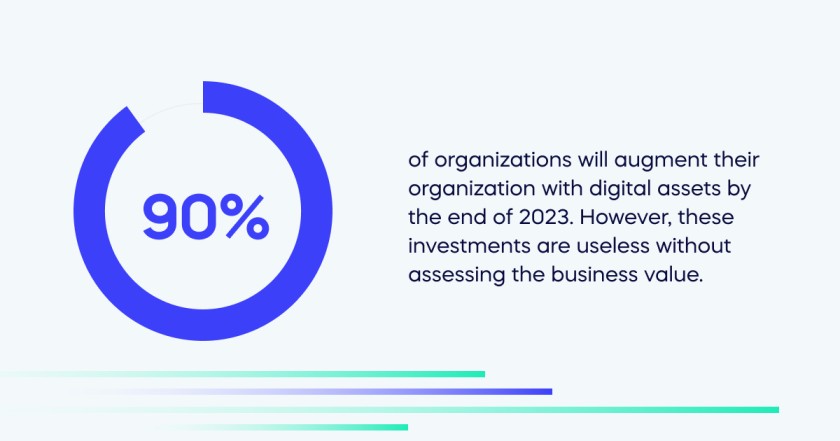
90% of organizations will augment their organization with digital assets by the end of 2023. However, these investments are useless without assessing the business value.
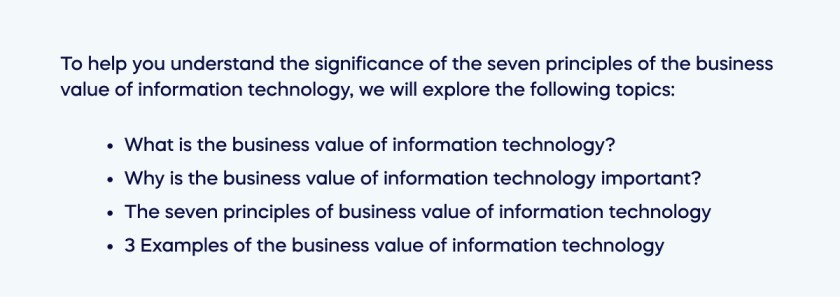
To help you understand the significance of the seven principles of the business value of information technology, we will explore the following topics:
- What is the business value of information technology?
- Why is the business value of information technology important?
- The seven principles of business value of information technology
- 3 Examples of the business value of information technology
What is the business value of information technology?
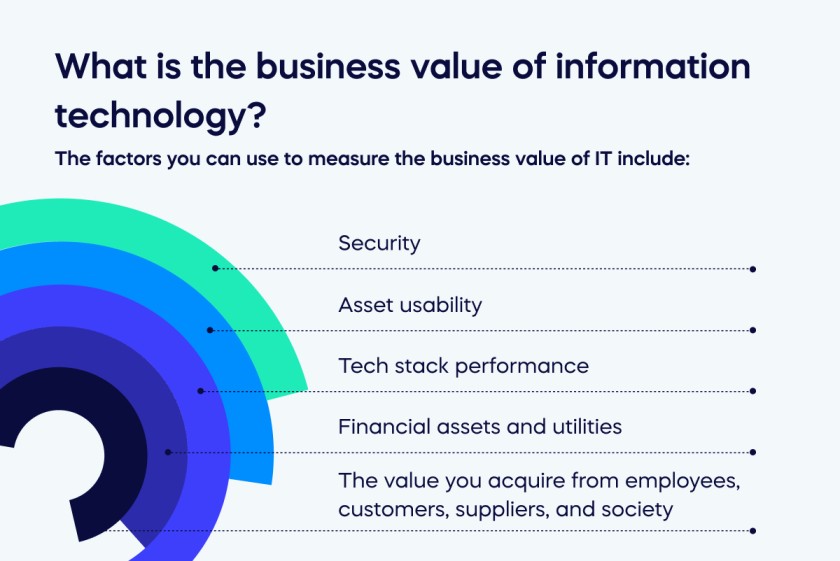
The business value of information technology involves the overall health and prosperity of the IT assets of a company, assessed through a comprehensive evaluation of intangible and tangible business value factors.
The factors you can use to measure the business value of IT include:
- Security.
- Asset usability.
- Tech stack performance.
- Financial assets and utilities.
- The value you acquire from employees, customers, suppliers, and society.
These elements serve as key indicators to gauge the effectiveness and success of a company’s IT infrastructure.
Why is the business value of information technology important?
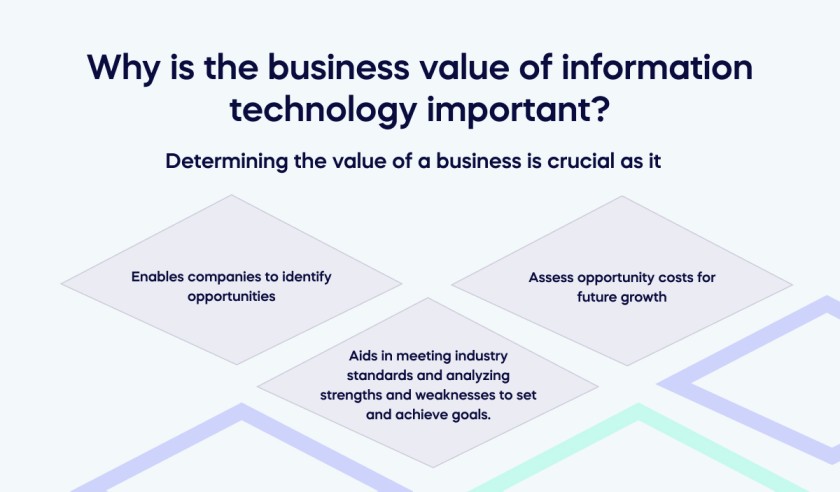
Determining the value of a business is crucial as it enables companies to identify opportunities and assess opportunity costs for future growth. It also aids in meeting industry standards and analyzing strengths and weaknesses to set and achieve goals.
Business value is pivotal in any company’s goals by improving overall functionality, streamlining product delivery processes, and enhancing customer satisfaction rates.
Inquiries regarding business value in the IT realm frequently come from stakeholders and executives outside the department. Therefore, IT leaders must grasp this concept to contribute effectively to the company’s objectives.
The seven principles of business value of information technology
There are seven principles of business value of information technology you will need to be aware of to structure your approach to the robust measurement of the value of your IT tech stack.
1. Understand that IT stakeholders determine the value
You can measure the value of IT by stakeholders and consumers, not the providers or producers. Therefore, to identify what truly matters, it is crucial to align with the business closely.
Without a clear understanding of business priorities, IT risks solely focusing on delivering technology or platforms rather than achieving business objectives, reaping benefits, or attaining desired outcomes.
Begin by identifying your key stakeholders, business partners, and consumers, with business leaders being the primary stakeholders. It is crucial to capture, validate, and consistently reassess their needs to ensure your business’s success and the highest economic value.
2. Be aware that all outcomes have different values
Collaborate with business leaders to identify and rank their strategic value priorities (for example, value/revenue increase, cash savings, and efficiency gains), then align IT resources to deliver the prioritized outcomes.
Capture and validate quantified benefits with key stakeholders and leadership within your business strategy.
Please note that in your organization, impacts on mission and revenue growth are generally valued more highly than spending avoidance and cost reductions.
Budget contributions are more valuable, as they are easier to measure and directly contribute to overall efficiency. Process improvements, although necessary, may not carry the same weight in terms of perceived value.
3. Forge two value narratives: transforming and operating
IT has the power to facilitate the smooth operation and transformative growth of a business. However, the perceived value of IT varies among stakeholders for different objectives.
Hence, the metrics used to measure value for “run” and change initiatives should be distinct. If one initiative encompasses both aspects, it is crucial to emphasize the differences and interdependencies in all relevant communications.
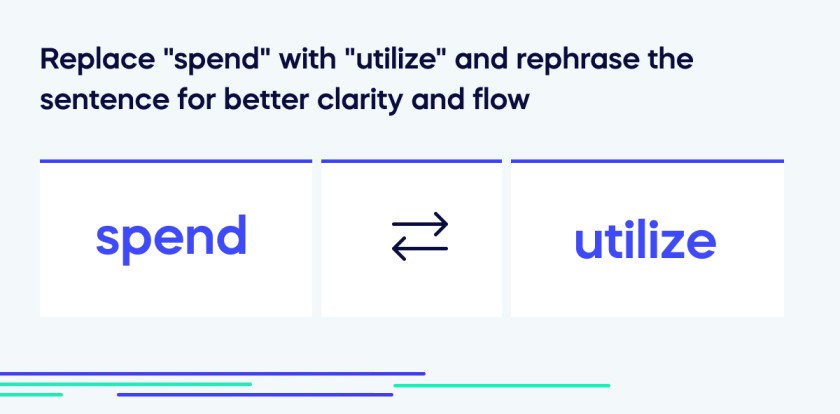
Measure the value of:
- Replace “spend” with “utilize” and rephrase the sentence for better clarity and flow: “Instead of focusing solely on spending, it is more effective to consider metrics such as return on investment.
- Seek to maximize performance while optimizing price – achieving better performance at a more affordable cost.
4. Focus on stakeholders’ objectives for value measurement
Focus on measuring business outcomes rather than IT work.
While platform, systems, and infrastructure performance are essential aspects of IT production, they do not directly quantify the value to business stakeholders or always align with each business goal proposition.
Capture the desired business outcome, as mutually agreed upon with stakeholders.
Next, evaluate the impact of IT on mission achievement or business outcomes and avoid metrics that merely convey effort, work, or technical output to ensure you reach the asset value for each new technology.
5. Align your IT costs to the business services they facilitate
Stholders can gain a deeper understanding of the value of IT when IT costs are associated with the business services and capabilities it provides.
Simply costing individual components or technologies falls short of fostering a meaningful conversation about value, although using an ROI calculator is a good start.
Accurate value discussions should encompass both the costs and benefits involved for the most efficient cost optimization practices.
Evaluate the value achieved at the business outcome level by considering the cost (e.g., cost per seat of an application or fee per transaction of critical business services).
It is essential to include costs and benefits in all project proposals to assess the net value accurately.
6. Communicate IT value in accessible stakeholder language
When conveying the value of IT, it is important to use business language instead of technical jargon and acronyms. Ensure your communication with business leaders is clear, relevant, and easily understandable. Craft your messages to drive decision-making.
Instead of diving deep into technology and platform capabilities, focus on translating value messaging into practical insights that empower critical business decision-making. This approach ensures clarity, readability, and eloquence while maintaining the original meaning.
7. Ensure those who fund IT understand its contribution to their objectives
Finance and business leaders who invest in IT must recognize the value and impact that IT brings to the business, even if they are not the direct beneficiaries. From the outset, involving economic decision-makers in defining the value is crucial.
IT should jointly justify spending and define its value when collaborating with key stakeholders. This collective effort ensures a more refined and practical approach.
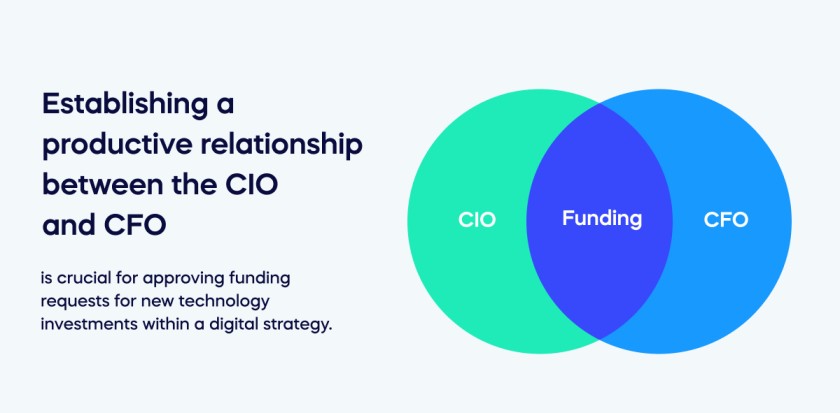
Venn diagram
Establishing a productive relationship between the CIO and CFO is crucial for approving funding requests for new technology investments within a digital strategy.
When the CFO and CIO have a strong partnership, they are more likely to secure funding for digital initiatives and ensure that digital spending aligns with the budget.
However, if the CFO and CIO fail to collaborate on an enterprise-level approach to measuring the outcomes and success of digital initiatives, funding for digital projects may fall behind.
Use a DAP to reinforce the principles of business value of Information Technology
With the ever-increasing competition, businesses must be creative and use adaptability to remain resilient. Information technology provides the tools and strategies that can help fuel a business’s growth potential, but they must be applied correctly.
A digital adoption platform (DAP) is the most effective way to ensure your organization adopts the seven principles of business value of information technology.
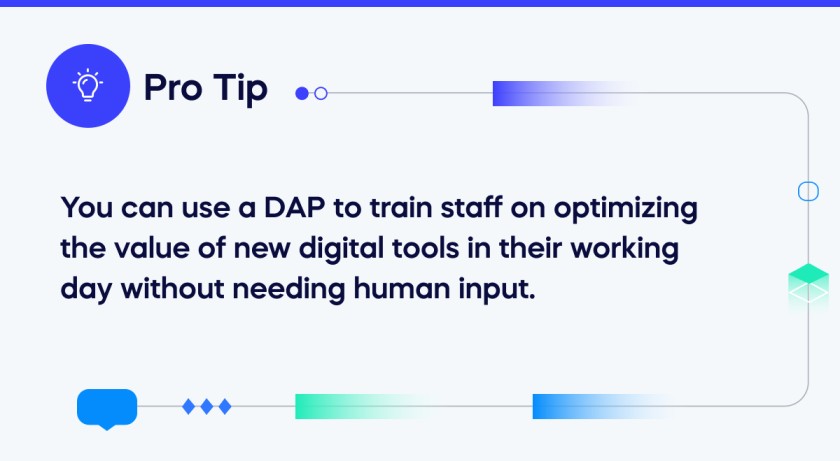
You can use a DAP to train staff on optimizing the value of new digital tools in their working day without needing human input.
Use the quantified value of a DAP to reinforce the seven principles of the business value of information technology, assess their effectiveness, and gain even greater returns going forward for your organization.
